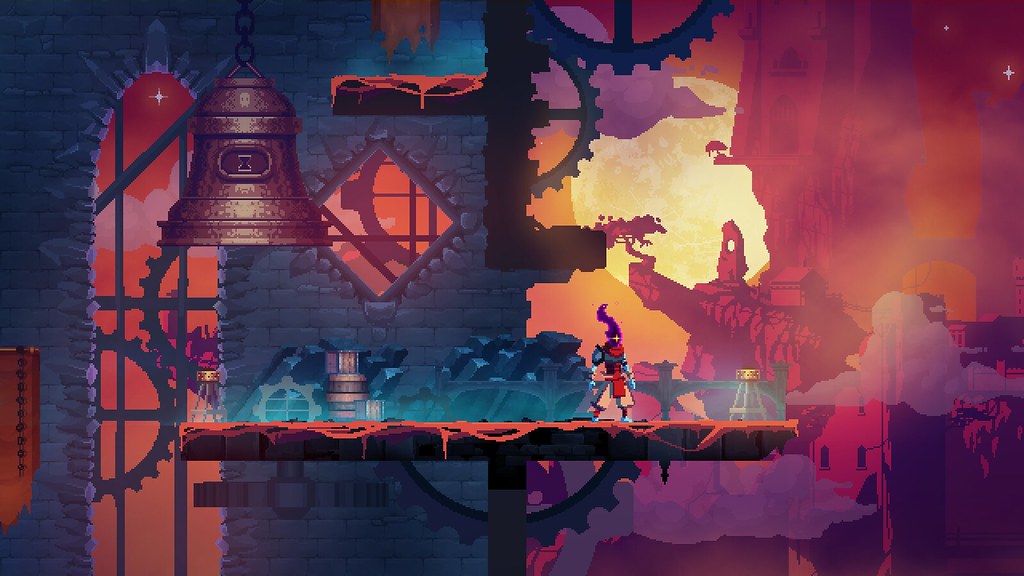At first glance, Motion Twin’s acclaimed roguelike platformer Dead Cells could be accused of being a little light on content – just a handful of ‘biomes’ and four bosses to master. Yet somehow the plucky French studio turned in 2018’s premier time-sink – a game that grabs you from the get-go and refuses to let go.
In the months since launch it’s become pure gaming comfort food – I cannot put the thing down. So why, given its leanness, has it got its hook in so deep? Let’s break it down:
Perfect ‘game feel’
Think of a game. Disregard its narrative, level design, puzzles and visual design. Would the simple act of moving around and interacting with that game’s world still be fun? If the answer is yes, that’s great ‘game feel’ in action. It’s a rare quality, but Dead Cells nails it.
Movement in Dead Cells is supremely polished, with every action offering a delicious snatch of environmental feedback. The way doors splinter like balsa wood when you crash through them; the shower of gold when you bust open a coin cache; the mechanical crunch of the game’s elevators whirring into motion. Every interaction is a joy.
And can you name a more satisfying ‘ground pound’ in all of gaming than the breathtaking “THHHHUNK” its nameless protagonist makes as it power-slams into the ground? It’s rivalled maybe only by Kratos’ axe-catch as the most pleasing button-press of 2018.
Given that Dead Cells demands you play the same levels over and over and over again for modest incremental reward, its ‘feel’ is completely central to its success. It’s often a game where the journey – not the destination – is the reward. And that journey is a loop, not a line, so round and round and round I go…
Secrets, riddles and rumours
Dead Cells wears its influences on its sleeve. Its sprawling map design is cut from Castlevania-hued cloth; its procedural generation engine doffs its cap to Spelunky; and the oblique, less-is-more world building is pure Dark Souls.
It’s a game stuffed with secrets and riddles. Who is the protagonist? Why are they here? What’s behind all those locked doors? What – and, more importantly, where – is the creature that’s escaped from the Toxic Sewers? Dead Cells is in no hurry to show you everything it has to offer, and even on my 213th run it’s offering up new surprises.
A friend recently bragged to me that he’d found a hidden room containing a game-altering Dark Souls-esque bonfire. That was news to me – and the longer I played without finding it, the more I suspected it was a fanciful Chinese whisper that had caught fire in the virtual playgrounds of the internet. Then, sure enough, 80-plus hours in and on my umpteenth play through, I rolled through a gap in the wall to find the chamber exactly as described.
With every playthrough, Dead Cells answers a few questions, and poses a few more, refusing to let you put it down and move on to the next thing.
Must. Collect. Everything.
Games have used all manner of elaborate infographics and flowcharts to communicate player progression through the years. Some are elegant, some are migraine-inducing – but none are as delightful as Dead Cells.
At the start of every run, just outside the door to the first area, your accumulated power-ups dangle from the ceiling in a dazzling array of glass jars, glimmering in the torchlight. It’s a beautiful visual mechanic.
But the tragic thing? Some of the jars are empty. Just a vacant space where a shiny, precious little tchotchke could reside. Put your ear up to the TV and maybe you can hear them whisper: “Fill me. Fill me. Fill me”. So, no matter how dispiriting your most recent demise, back you go into the fray for one more go-round on Dead Cells’ Sisyphean spinning top.
Player choice matters
There are bits of Dead Cells I really don’t care for. The Toxic Sewers are a wretched ordeal; the Conjunctivius boss fight does not jive with my play style at all; and you may as well arm yourself with a rusty spoon than wield that infernal Broad Sword.
And that’s fine, because the game doesn’t force you to endure any of the above. The experience is almost entirely customisable, from the route you take through the game, to the items you decide to pick up.
Whether you want to stay in your comfort zone and spam turret skills from a safe distance, road-test some of the game’s more esoteric powers, or throw caution to the wind and attempt to unlock those speed-run gates – Dead Cells is there for you, offering a different experience every time.
A perfect learning curve
Like all great games, Dead Cells delivers on the “easy to play, hard to master” maxim. It gradually drip-feeds you items, powers and hard-won experience until, without noticing, you’ve evolved from a pitiful weakling into a mutant-wrecking agent of mass destruction. It’s a game you’re constantly improving at – even when you’re failing miserably.
I remember comparing notes with colleagues the first weekend after launch. I was eight hours in and had come up against the first boss a couple of times. I could never conceive of a time where I would be capable of taking that thing down. Fast-forward 80 hours of playtime and it’s a breeze.
Right now I feel the same way about Hand of the King on NG+. Every time I face it, I last a few seconds more. And en-route to that inevitable defeat I sharpen my skills, buff my RNG stat, unlock a new item or two, and inch a little closer to victory. Any day now, then I can finally put this game down and move on. Right?
What was your favorite game of 2018? Click here to vote in the PlayStation.Blog Game of the Year 2018 Awards!













